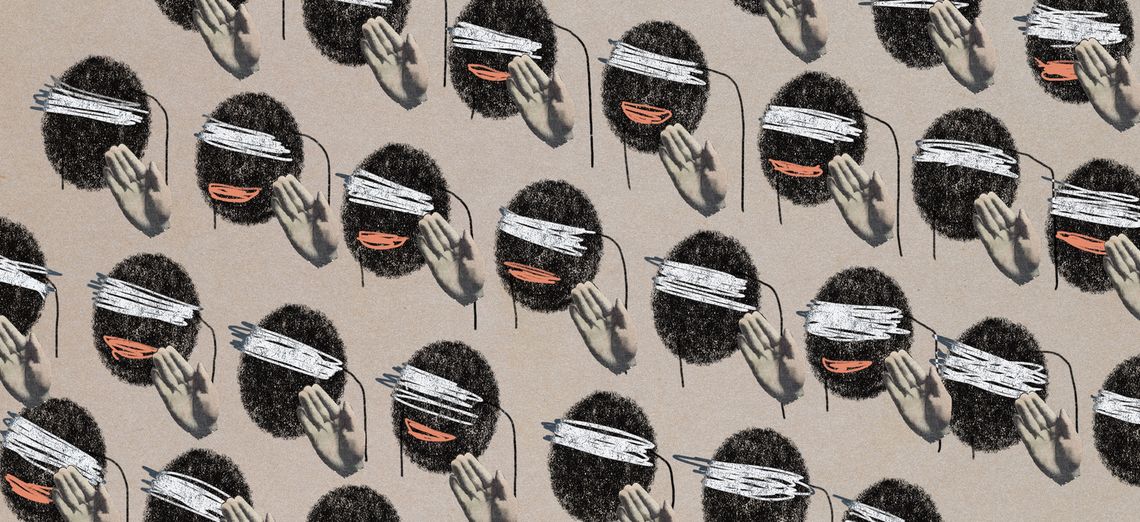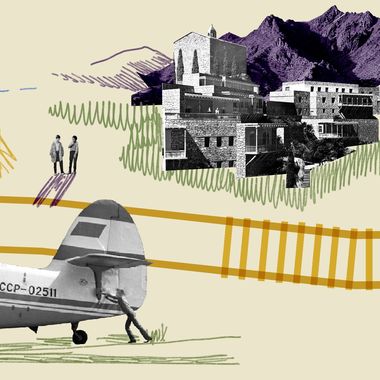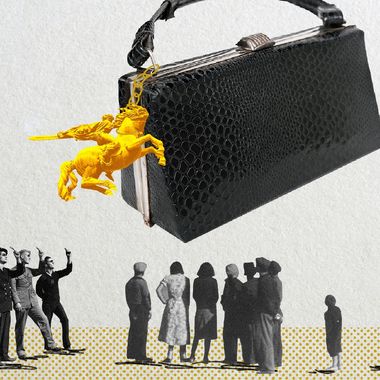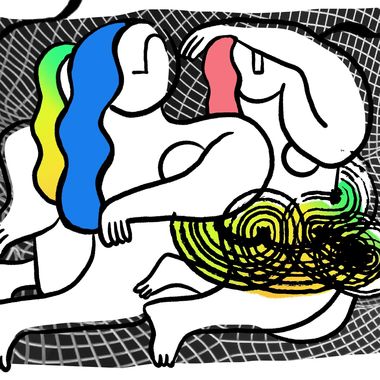
Illustration by Armine Shahbazyan.
In critical and theoretical circles, political cinema is usually divided into two main subgroups: conformist or oppositional, ‘marked’ or ‘unmarked’. If conformist films accept dictated power systems, then oppositional cinema resists those regimes. In ‘marked’ political cinema, the authors openly show their views and positions, in ‘unmarked’ films they are hidden or presented in the form of allegories. However, regardless of the orientation, any film, or any work of art in general, is created on the basis of the fact that it has a political position from inception, even if that position claims to be completely apolitical.
Throughout the existence of cinematography, many political figures have realized the propagandistic potential of the medium and tried to use it to spread or strengthen their agendas. Among them were Lenin, Hitler and McCarthy. Along with the development of cinematic language, the opposite process began: directors used their craft to criticize and oppose the authorities. A perfect example of this are the directors working in Spain during the Franco regime (Juan Antonio Bardem, Victor Erice, Carlos Saura), who used a complex system of allegories in their films to express their disagreement and dissatisfaction with the dictatorial system in the country.
Since the history of cinema in Armenia began immediately after the establishment of the Soviet regime, the same imperatives and subjects were actively circulated here as in the whole Union. The very first Armenian film, “Soviet Armenia” (1925), was created as an ode to the ruling power and ideology. In the context of the communist dictatorship, almost the entire Soviet cinema industry became a mechanism for glorifying the regime, while opposing or critical views could only “crawl” onto the screen in the form of cleverly-veiled hints and ingenious half-jokes. Only after the proclamation of the Third Republic did Armenian cinematography begin to move away from direct political functions, and to some extent, from the ruling ideologies as well.
It seemed that after such an event as the Velvet Revolution, modern Armenian cinema should have been flooded with films about it or against it. However, the only feature-length film dedicated to the revolution until recently was Garin Hovhannisian's documentary “You Are Not Alone”, which premiered at the Toronto International Film Festival in September, 2019, but since it was bought by Netflix, it did not reach the big screens. This film documented in detail the course of the revolution – from the march in Gyumri to the election of Nikol Pashinyan as Prime Minister. A revolution-themed short film was also made by the young director Vahan Khachatryan, whose documentary entitled “Revolution” was one of the few films screened during the “war-pandemic” program of the Golden Apricot International Film Festival in November, 2020.
But in the spring of 2021, before the elections, a completely different kind of movie appeared on all the cinema screens of Armenia, the likes of which we had not witnessed in Armenian cinema for a long time: it was Mher Mkrtchyan's “Ishkhanutyun” (Power) drama. The director, who is known to the Armenian audience for his ‘blockbuster’ "Life and War", tries to “summarize the events of the last three years of our lives” with his new work. The story of the film starts in April, 2018, when an anonymous politician decides to walk from Gyumri to Yerevan with a small group of his supporters to fight against the permissiveness and abuses of the ruling authorities. We all know the continuation of the story: the president resigns, a coup takes place, and young political forces separating people into “blacks and whites” come to power. Whilst everyone is rapidly changing their positions and views, the presidential aide – the idealist, Alisa – remains loyal to her leader and takes on the burden of an unequal struggle against the newly elected prime minister. Soon a war breaks out.
Mher Mkrtchyan attempts to build the film around the actively circulating thesis that all the actions of the previous authorities were aimed mainly at preserving the Artsakh Republic; meanwhile the new leadership failed that mission. However, all the dramaturgical tools used to reinforce this thesis seem to have been taken from a cheap and badly translated manual. In addition to the wise sayings (quite often made by the president) to justify the behavior of criminal groups or individuals in the country, Mkrtchyan uses a primitive montage to create a cause-effect relationship between the revolution and the Artsakh war. Scenes depicting people gathered in Republic Square during the days of the revolution are regularly interspersed with the bombings of Stepanakert, and the videos of the martyred soldier Albert Hovhannisyan firing a cannon – images which had flooded Armenia a few months before. Wounded or paralyzed soldiers also appear on the screen, as well as the black ribbons hung up in various districts bearing the names of the fallen soldiers.
Since the characters of the films “Ishkhanutyun” and “You Are Not Alone” essentially coincide – despite the difference in the genre of the films – it is interesting to make a comparison between the directors' approaches in presenting their characters. All the characters in “Ishkhanutyun” are extremely one-sided; the prime minister is ambitious, disgusting, while the president, who has resigned from power, is very insightful and wise. The main character, Alisa, is predictable and dull, and although in the first scenes the director refers to Lewis Carroll's famous novel, during the film he makes no effort to make use of the character of the Carollian curious girl to enrich his heroine in any way. Of course, Garin Hovhannisian's heroes also do not travel in “wonderland” at all, but the director tries to listen to and discover the “opposite side”; here, the interviews with former President Serzh Sargsyan and former Chief of Police Valeri Osipyan give a more rounded image of the revolution.
Apart from the fact that the two directors have different views of the revolutionary events of 2018, their method of advancing their position or thesis is also different. “You Are Not Alone” is of an observational nature, despite the director's open sympathy for the revolution, while Mkrtchyan's film is extremely manipulative. The latter has perfectly calculated what words, what developments of events should be conveyed on screen in order to make the deepest possible impact and to move the audience. The film makes no revelations, but only continues to feed the gossip mill; all the expressions and sentences that can be heard on the streets of Yerevan while sitting on the bench are heard from the screen. And considering the short amount of time the script was written in, and the second part of the film – the war – was shot, the level of depth in this political drama (or its absence) does not cause much surprise. On the other hand, the image of a missing soldier, the relocating of relatives' graves from Artsakh to Armenia, the decisions to burn houses, which are accompanied by sentimental music, often serve their purpose – most of the viewers leave the cinema with tears in their eyes. For a more vigilant audience, however, such exploitative use of these still-raw tragic episodes only evokes ethical disgust.
With its manipulative and one-sided nature, “Ishkhanutyun” is reminiscent of Ruben Gevorgyants' film “Time to Collect Stones” (2002), a five-part documentary that was made after Robert Kocharyan was elected president, and was aimed at criticizing and blackening the former government. In addition to the similarities in the sentimental means of expression, in this film the director also sees a cause-effect relationship between the independence of Armenia and the death of 15,000 soldiers killed in the first Artsakh war.
The advertising campaign for “Ishkhanutyun”, unlike the film itself, was quite impressive. A short time after the film’s premiere, the director also conducted a highly-publicized, ‘exclusive’ interview with Serzh Sargsyan. They discussed the events of the last three years, and the President expressed his point of view on all the developments. During the interview, Mkrtchyan made comparisons between the hero he created and the thoughts expressed by Serzh Sargsyan, which surprisingly coincided. Besides being screened in all cinema theaters throughout Armenia, “Ishkhanutyun” was also soon posted on the Vimeo platform to become more accessible to the Armenian audiences living abroad. The campaign did not avoid vulgarity; the announcements posted on social networks were made in two languages – Armenian and “Nikolian”, the later being fashioned to sound like gibberish.
Mher Mkrtchyan has made a marked and oppositional political film, which, however, is too superficial and collapses under the incredible transparency of its agenda. It does not try to bring forward any ideology, to open or explain something new to the audience, to motivate them to reconsider their views through critically persuasive discourse, or at least, inventive artistic solutions. The director simply tramples on everyone's wounds and throws the mistakes of the past back at people’s faces, wanting to justify the unforgivable. As a result, the audience gets a film that is more like a 90 minute pre-election video than a political film...
After all, the appearance of this film in our post-war reality also speaks of a more serious problem. Propaganda films have always been and will continue to be made. But alongside them, filmgoers are also accustomed to seeing real works of intellectual contemplation aimed at the search for truth and resistance to falsification, which sincerely strive to make the tangled, dark mechanisms of politics more transparent and tangible for the ordinary viewer. Such political cinema can influence the course of reality and even change it toward more just and people-centered directions. It remains one of the most essential, necessary means of improving public life, society and restraining the ruling systems. The almost complete absence of this tool in Armenia’s series-loving mass culture and reality-shunning sphere of popular art can be considered an acute symptom of a weak and underdeveloped social/national ecosystem.
Հայերեն
Կինոէկրանը քաղաքական ռազմադաշտ
By the same author
Did the Wind Drop? Nora Martirosyan's Optimistic Drama From Artsakh
By Sona Karapoghosyan
Director Nora Martirosyan’s film “Should the Wind Drop” reveals the frustrating situation surrounding the airport as a starting point to delve into the history, problems and spirit of Artsakh.
“Where Are You, Soghomon?” Arman Nshanian’s Melodrama About Komitas
By Sona Karapoghosyan
“Songs of Solomon” promises to tell the story of young Komitas but ends up disappointing as the direction drastically changes, turning into another tragic film about the Armenian Genocide and Komitas simply a faded symbol emphasizing a lost culture and history.
More from Et cetera
Meghri: A Fuselage of Memory
By Tigran Amiryan
There is a Facebook group of Meghri natives that is more active than the official pages of many institutions. It is, however, also isolated, living a separate life, disconnected from the rest of the digital world just like the actual city.
Notes From a Future Museum: Bagging Up Ideologies
By Vigen Galstyan
How a black evening handbag found among countless items in Yerevan’s largest flea market revealed a paradigmatic shift from the egalitarian criteria of Soviet ideology, which accorded functional objects with purely practical properties.
The EDM Kitchen։ Electronic Dance Music in the Context of Gender
By Eva Khachatryan
Electronic dance music, as a relatively new cultural phenomenon, could have been occupied by women, but even here, the presence of men is predominant and women have to fight for fair representation.








